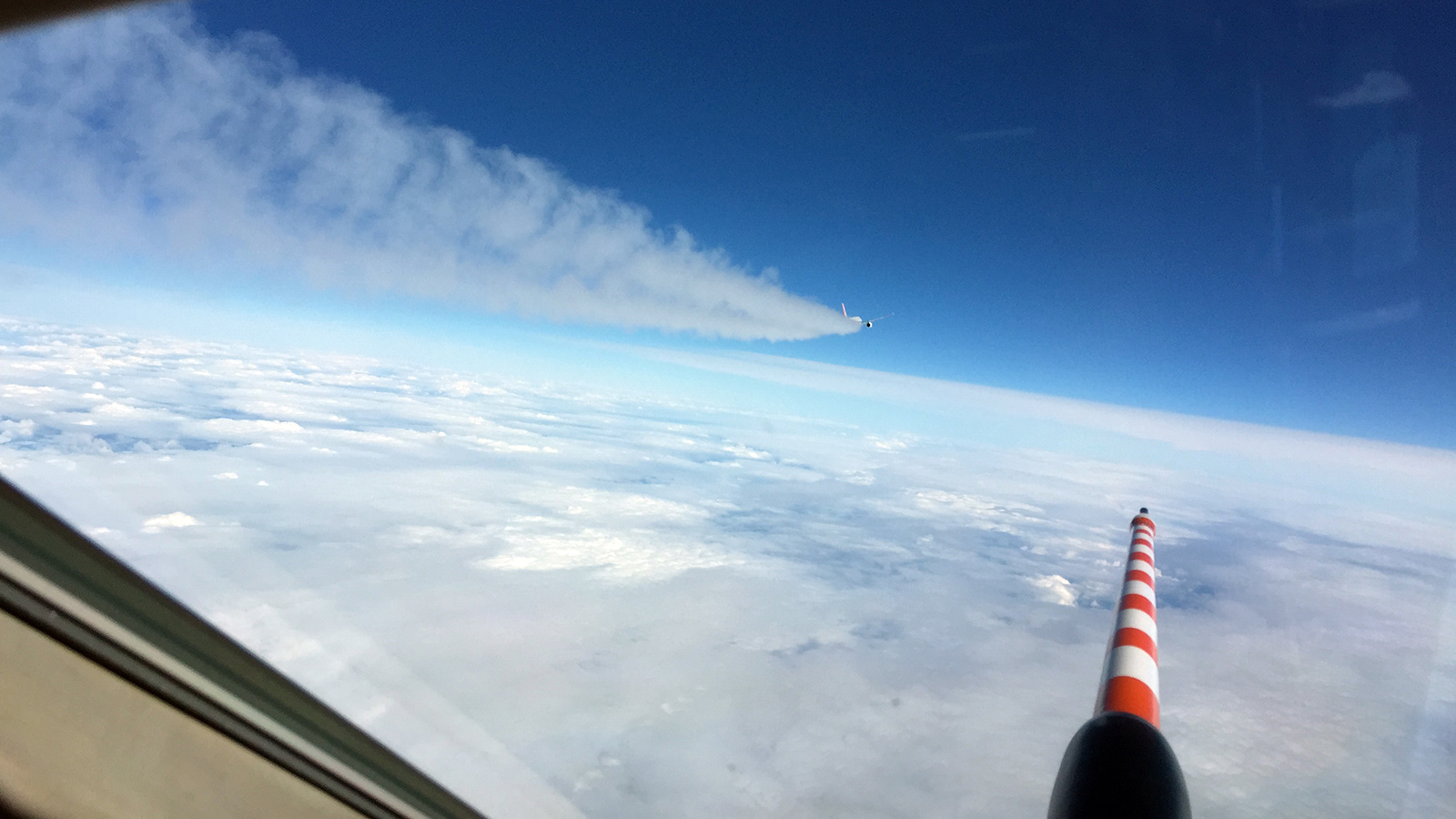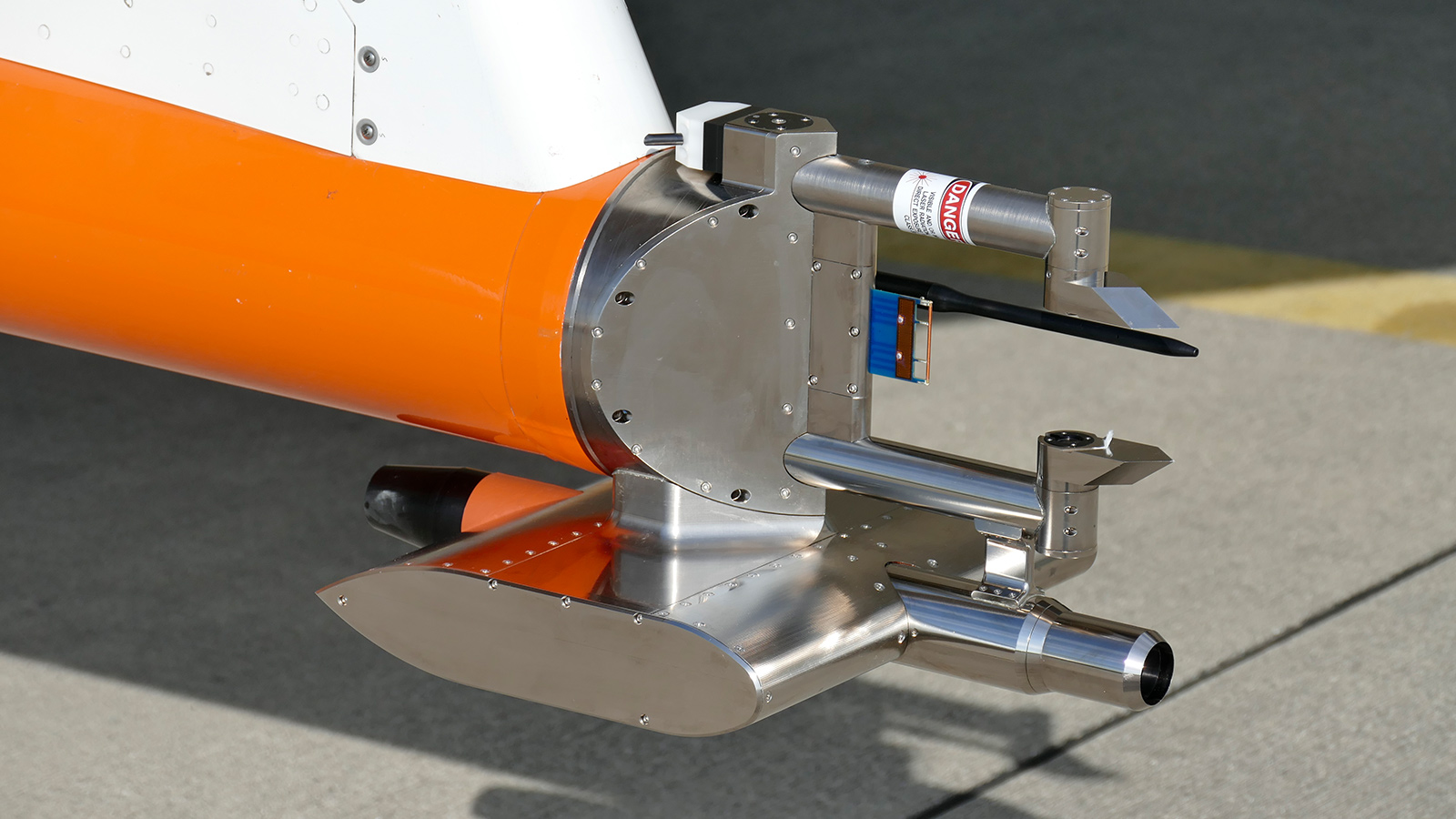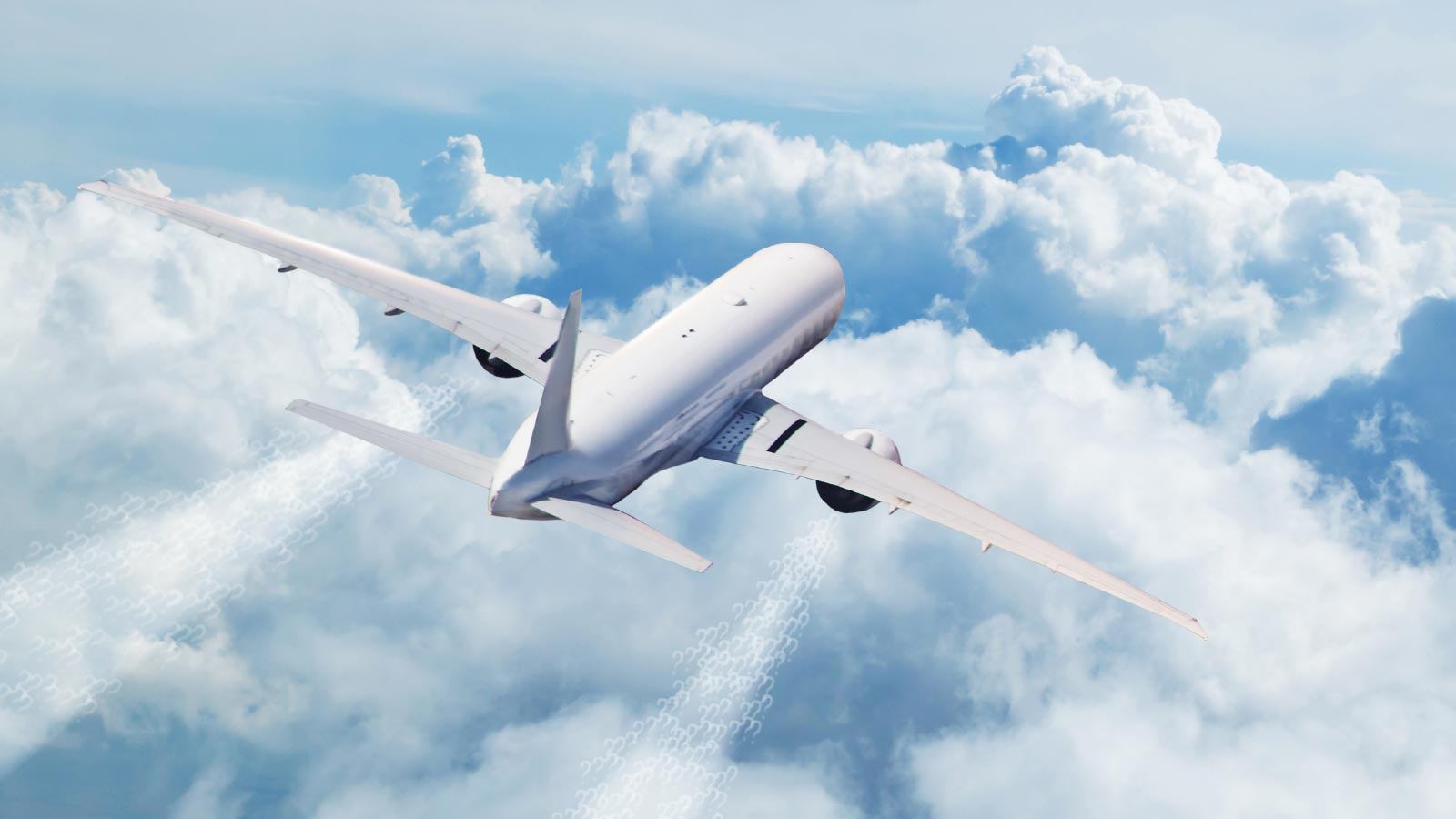Stay Up to Date
Submit your email address to receive the latest industry and Aerospace America news.
As surprising as it might be, contrails exceed carbon dioxide as jet travel’s greatest contributor to global warming. Reduce the contrails, and you could immediately soften the sector’s climate impact. Achieving that could be the hitherto unspoken benefit of shifting aircraft to sustainable aviation fuels derived from crop residue or food waste. Keith Button spoke to scientists who are measuring the effects.
It isn’t easy counting and measuring ice crystals in a cloud formed by a jet plane 32,000 feet up. But it’s necessary work for climate scientists who hope to show how formation of condensation-trail cirrus clouds of ice crystals, also known as contrails, might be reduced by choosing the right kind of jet fuel. Contrails are aviation’s largest contributor to global warming, and they cannot be accurately replicated in a lab.
Many of the climate scientists from Europe who flew instruments behind an Airbus A320 three years ago took to the air in April this year to begin the next phase of their crystal research, this time with an A350-900 chased by a Falcon 20E, plus ground tests in Toulouse, France. They’re also about to publish findings from the earlier flights, and they say the news is big: Powering the aircraft with a 50-50 mix of regular jet fuel and a sustainable aviation fuel, or SAF, resulted in fewer ice crystals than when the plane burned 100% conventional fuel. Next, the scientists want to find out how far contrail production falls when a jet runs entirely on SAF, something not currently allowed except in an experiment like this one over France. The ongoing research suggests that the air transportation industry could, in theory, immediately reduce its global warming impact through a rapid shift to SAF, given that the warming effect of contrail clouds goes away when they dissipate. That said, the expense of such a shift remains a high hurdle.
Making the connection
Before they took off on a DC-8 for the 2018 flights, the scientists knew from similar flights in 2014 and 2015 that contrail ice crystals form around soot particles and that a 50-50 blend of regular jet fuel, which is kerosene, and a fuel from plant and animal fats produces fewer soot particles. The 2018 flights closed the loop by gathering the first experimental proof that fewer soot particles, in this case produced by a 50-50 fuel blend, indeed spelled fewer contrail ice crystals. The new flights, like those in 2018, will test a SAF called HEFA, short for hydroprocessed esters and fatty acids, but this time the fuel will be all HEFA instead of a 50-50 blend.
Other SAFs can be made from municipal waste, from forest waste or by processing water and carbon dioxide into hydrocarbons with solar electricity.
Why do SAFs result in less contrail coverage? Because they have fewer hydrocarbon aromatics, hydrocarbon molecules that are more likely to be chemically changed during combustion into the pure carbon soot particles that ice crystals form around. Aromatics make up as much as 25% of kerosene, but most SAFs have no aromatic content.
In the flights three years ago, the scientists from DLR, the German Aerospace Center; NASA; the Max Planck Institute and the University of Oslo flew nine flights in a DC-8 chase plane over Germany, collecting samples of the emissions in the contrail of an A320. They cruised at an altitude of 31,000 feet, where temperatures hovered around minus 60 degrees Celsius. The chase plane followed at 20 to 30 kilometers behind the A320, where the contrail was 1 to 2 minutes old and clearly visible: a merged cloud formed from the two contrails left by the two engines on the A320. The chase plane’s pilots would descend into the tube-shaped contrail, which was about 200 meters deep and 70 meters across, and then the scientists on board the DC-8 would direct them more specifically where to fly for the best position for measuring ice crystal numbers and sizes, soot particle density, carbon dioxide concentrations, water concentrations, relative humidity and temperature.
They didn’t collect the ice crystals — the crystals would’ve simply evaporated at the inlet. Instead, two-prong cloud probes attached to the roof and under the wings of the DC-8 sampled the contrails. Each probe shined a laser across the gap between the prongs and at the same time detected the light scattered by the individual ice crystals in the contrail, which revealed the number of ice crystals per cubic centimeter and their size. Similarly, the probe also detected shadows cast by the larger ice crystals that made up naturally occurring cirrus clouds — typically 100 micrometers in diameter compared to 1 to 10 micrometers for contrail ice crystals — to count and measure those. All told, about 100 scientists worked on the project, including those who ran ground-based testing and analysis, where emissions samples were collected from a parked A320.
Out the windows of the DC-8, the scientists couldn’t see a noticeable difference between the contrails produced during the 100% kerosene flights and the contrails produced by the 50-50 blend flights, says Christiane Voigt, a DLR climate scientist and lead author of the paper on the findings. The differences also weren’t immediately known from the in-flight measurements. Counting ice crystals and soot particles wasn’t enough; the scientists also had to calculate how conditions such as humidity, temperature, trailing distance, winds and the A320 throttling up or down were affecting the ice crystal formation at the time of measurement. They also tracked carbon dioxide to calculate fuel consumption at the time of ice crystal measurements and, ultimately, the amount of ice crystals formed per kilogram of fuel burned. “To take into account all of these dilution effects, that’s a rather complex analysis,” Voigt says. “That’s also why it took quite awhile to get those.”
The scientists learned that the 50-50 blend of kerosene and HEFA produced a 50% to 70% reduction in soot and a corresponding reduction in contrail ice crystals.
Heightened interest
The findings from the 2018 flights take on added importance in light of a newly published assessment of aviation’s climate impact in the January issue of Atmospheric Environment. The assessment, “The contribution of global aviation to anthropogenic climate forcing for 2000 to 2018,” reported that aviation contributes 3.5% of human-induced global warming effects, with contrails comprising the largest portion of aviation’s total. Contrail ice crystals reflect sunlight away from Earth — a cooling influence — but they also trap heat radiating from the Earth — a warming effect that outweighs the cooling. Contrails contribute about 67% more to aviation’s global warming effects than carbon dioxide emissions, the second-largest contributor, and more than twice that of nitrogen oxides, which are third on the list. That means cutting contrail formation would have the largest and fastest impact on aviation’s global warming.
“They have lifetimes of hours, so if we could avoid contrails or if those contrails can be mitigated by using those biofuels, then the effect on climate will be immediate,” Voigt says. “If you really want to reduce the climate impact from aviation soon, in the next year or even in the next weeks to months, then we have to think of those short-term mitigation options, and that’s what contrails are.”
The 2018 flights also dismissed any notion that ice crystals might form around non-soot particles in the emissions, Voigt says. Before the 2018 tests, some scientists had theorized that tiny particles of volatile compounds, such as droplets of sulfuric acid, might serve as nuclei to form contrail ice crystals. But the tests showed that these particles were too small, at about 3 nanometers in diameter, or 0.000003 millimeters, for water to cling to, Voigt says. Soot, on the other hand, was an efficient nuclei for ice crystal formation: About 90% of the soot particles, which are 30 nanometers wide — about one-three-thousandths as thick as a human hair — formed ice crystals under the contrail conditions.
Fewer soot particles means fewer ice crystals. Less soot also leads to larger ice crystals, which may produce another benefit: The larger ice crystals drop out of the contrail and sublimate more quickly, so the contrail dissipates faster. The scientists discovered that the ice crystals produced during the 50-50 blend flights were slightly larger than the crystals left by unblended kerosene flights, because the moisture in the air had fewer ice crystals to cling to. How much faster the larger ice crystals might drop out of a contrail is difficult to quantify, in part because the scientists could only measure the crystals when the contrail was 1 to 2 minutes old, and not what occurred as the cloud grew older, Voigt says. A contrail’s lifespan is typically one to six hours.
Sticking with aromatics
While aromatics are the source of soot, they’re also considered an essential fuel ingredient by some plane manufacturers. They have pushed regulators to require alternative fuel blends to include a minimum 8% aromatics because they cause nitrile O-rings to swell and seal better, which prevents fuel system leaks. But newer O-rings are made from fluorocarbons that don’t need the seal-swelling effect of aromatics, which means the 8% limit could be lowered if testing proves the aromatics are no longer necessary, says Patrick Le Clercq, DLR’s coordinator of alternative fuels research, who was a principal investigator on the 2018 flight tests.
Given that a 50-50 kerosene SAF blend reduces soot so significantly, what’s to stop all of the airlines from flying with the 50-50 blends tomorrow? The answer comes down to cost and SAF availability.
Currently there are eight types of SAFs that are approved “drop-in” options, meaning a jet engine can burn mixtures of them with kerosene, in most cases up to a 50-50 blend, without any modifications.
But the fuels on this list can be purchased only in small amounts, which means there is no market established, Le Clercq says. Purchase agreements for the fuels are private, so the specific prices are unknown, but observers estimate that the prices are two or three times that of kerosene, Le Clercq says. Airlines that do buy alternative fuels now blend them at 30 parts SAF to 70 parts kerosene, at most.
Scientists also haven’t determined how much contrail coverage and other global warming factors could be reduced by flying with 100% SAF. New airplanes are being designed to fly on 100% SAF, with Boeing, for example, announcing that its current and new planes will fly on all-SAFs by 2030. Existing airplanes that were designed for kerosene could conceivably fly safely on only SAF, but extensive testing would be required first, Le Clercq says. Like kerosene, the 100% SAF would have to stay liquid with no degradation at high altitudes and at minus 40 degrees Celsius and remain unaltered as it heats up substantially and acts as a coolant while traveling through the fuel system from the tank to the injectors in the engine. Every component that is in contact with the fuel has to be checked to make sure it won’t cause something to break down and crash the plane, and numerous properties have to be analyzed, including density, viscosity, electric conductivity and energy content to make sure that the fuel won’t ignite too early, for example, or evaporate.
Kerosene has some 200 types of molecules, and a SAF has a lot to prove to fuel producers, engine and airplane manufacturers, operators, standards organizations and regulators before it can pass muster as a replacement.
Kerosene remains the same “whether you’re starting at the equator or Alaska; it’s an amazing mixture,” Le Clercq says. “It took years to fine-tune it so that the modern engines, the modern systems, can use it.”
It’s a long research and check process before we can say: ‘Yes, let’s do that.’ But there’s definitely on the other side a huge potential and big advantages of using these types of alternative fuels,” he says.
Beyond the contrail-reducing effects of SAFs are the reduced carbon footprint benefits. SAFs contain a higher energy content than kerosene, which means they burn more efficiently and produce less carbon dioxide emissions. But their main carbon footprint benefits are from the plant-, waste- and renewable energy-based production of SAFs. Overall, SAFs contribute a 60% to 80% reduction in carbon dioxide in the atmosphere compared to kerosene, according to the DLR, which equates to a 30% to 40% reduction for a 50-50 fuel blend.
Carbon dioxide lingers in the atmosphere for 100 years or longer, which is why those who are concerned about climate change are determined to reduce the emissions anywhere they can, including in the air transportation sector. The long lifespan of carbon dioxide adds urgency to the search for quickly reducing climate-warming emissions.
“The sooner we start, the better,” says Le Clercq about pushing beyond the current 50-50 limits on SAF blends. He says there’s no time to wait for exotic new aircraft and engine designs that would be fueled by hydrogen. “It will be too late.”
Contrails in perspective
While studies definitively show that contrails are the No. 1 warming factor from aviation, the newly published aviation climate impact assessment also shows that the gap between contrails and carbon dioxide at No. 2 on the list may not be as wide as previously believed, says Ulrike Burkhardt, another DLR climate scientist.
Clouds are always difficult for scientists to estimate in their climate models, and many suspect that contrails might take away moisture from the formation of natural clouds. That could retard the formation of natural clouds and their own warming effect, lessening the net warming effect of contrails plus natural clouds.
The best strategies for combating the overall climate impact of aviation would be to reduce both contrail formation and carbon dioxide emissions, Burkhardt says. That would not favor, for example, a strategy of flying around atmospheric areas where contrails are more likely to form if that means burning more fuel and creating more carbon dioxide emissions.
“We always need to remember that we don’t know everything about the climate impacts of aviation and that what we do know is partly connected with very large uncertainties,” Burkhardt says. “It could be a very risky strategy trying to avoid contrails at the cost of having larger greenhouse gas emissions.”
For the April flights, Le Clercq, Voigt and others set out to reduce uncertainties about the scale of the reduction effect. The flights, which are a joint project with Airbus, engine maker Rolls-Royce and fuel producer Neste of Finland, will pause and pick up again in October.
Voigt, who leads DLR’s planning for the April and October flights, says the scientists expect the 100% SAF will produce less soot, but they don’t know how much less.
“That’s just the question,” she says. “There will still be unburned hydrocarbons, but how large is this reduction? That is one of the important topics to be investigated.”
“It’s a long research and check process before we can say: ‘Yes, let’s do that.’ But there’s definitely on the other side a huge potential and big advantages of using these types of alternative fuels."
Patrick Le Clercq, DLR
About Keith Button
Keith has written for C4ISR Journal and Hedge Fund Alert, where he broke news of the 2007 Bear Stearns hedge fund blowup that kicked off the global credit crisis. He is based in New York.
Related Posts
Stay Up to Date
Submit your email address to receive the latest industry and Aerospace America news.







